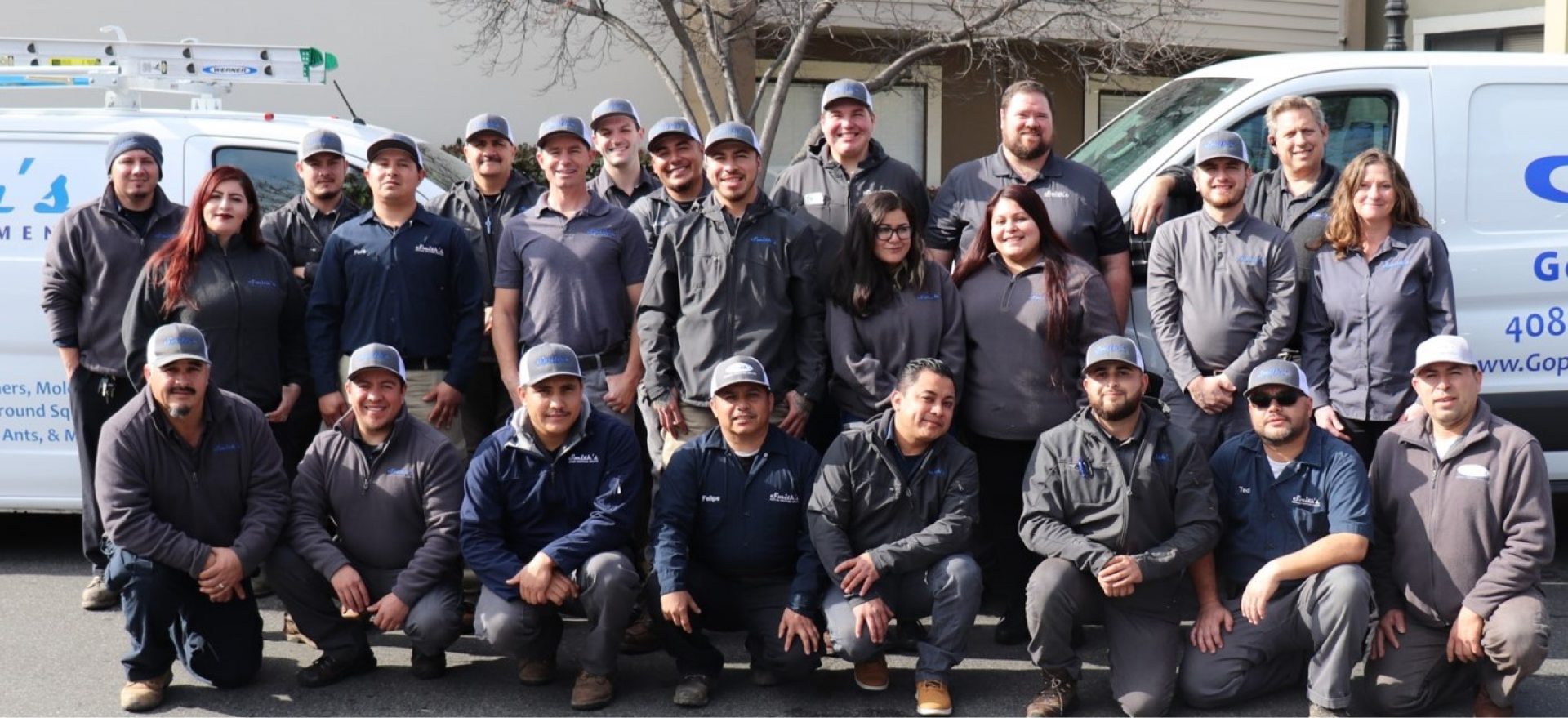Have you noticed mysterious holes or mounds of dirt in your lawn? You might be dealing with burrowing rats.
If you’ve walked out into your backyard and found fresh dirt piles or small holes along your fence line, deck, or garden beds, there’s a good chance you’re dealing with rats—specifically, burrowing rats like Norway rats.
These rodents are notorious for building intricate tunnel systems right under our feet, often going unnoticed until the damage is already done.
Rat holes in the yard aren’t just unsightly—they’re a sign of a deeper problem that won’t go away on its own.
In fact, ignoring them can lead to property damage, health hazards, and full-blown infestations.
In this comprehensive guide, we’ll show you how to identify rat holes, understand why they’re there, and walk you through safe, effective strategies to reclaim your yard.
Are Those Rat Holes… or Something Else?
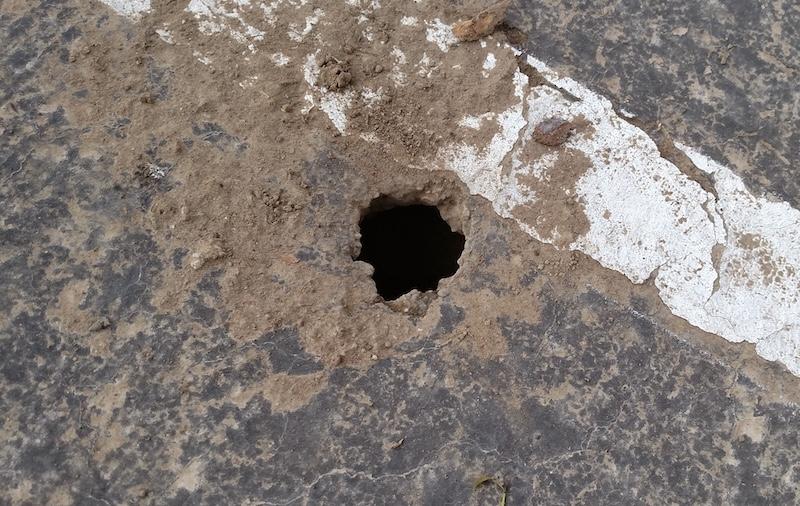
Before you jump to conclusions, take a moment to confirm whether the holes in your yard are caused by rats.
After all, several animals dig holes, but each species leaves behind different clues.
How to Identify a Rat Burrow:
- Entrance Size: Norway rat burrows usually have entrances that are about 2-4” in diameter.
- Fresh Soil: Look for loose, freshly dug earth around the hole. This is important because rats push soil outward as they dig.
- Tail Drag or Grease Marks: Rats have greasy fur, which means they often leave greasy smudges and visible tail drag marks near the hole’s entrance.
- Droppings: Rat droppings are capsule-shaped and about ½ inch long, and can often be found near entrances or along pathways.
- Activity at Night: You may see or hear rats after dusk, especially around food sources or near their burrow.
What Else Could It Be?
- Moles: Moles create mounded tunnels just beneath the surface with no visible entry hole.
- Gophers: Gophers make crescent- or horseshoe-shaped mounds with plugged entry holes.
- Ground Squirrels: Squirrels create large holes and are most active during the day.
- Snakes: Although snakes may reuse abandoned burrows, they don’t dig their own.
- Voles: Voles dig lots of little holes all over your yard, which can mess with plant roots and cause damage to your lawn or garden.
Still unsure what kind of animal you’re dealing with?
You can sprinkle flour, talcum powder, or sand near the hole and check for footprints the next morning.
To figure out if you’ve got rats, look for prints about ¾ to 1 inch long—rats have four toes on their front feet and five on the back, and you’ll usually see a little tail drag mark running between the footprints.
Why Are There Rat Holes in My Yard?
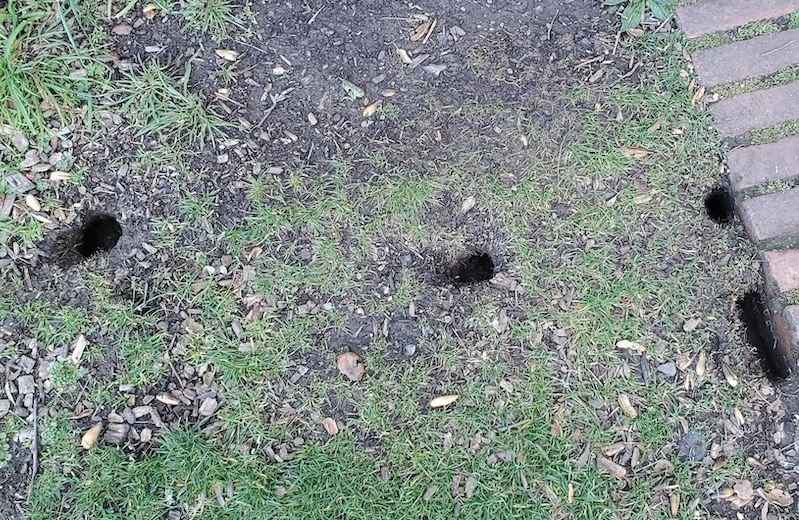
Rats are smart, adaptive animals.
If you’re seeing burrows in your yard, it means your property probably offers all the things rats need to survive — food, water, shelter, and a safe place to nest.
Here’s what draws rats to backyards:
1. Food Sources
Unsecured trash bins, compost piles, fallen fruit, birdseed, and pet food left outside are all perfect snacks for hungry rats.
Rats have an excellent sense of smell.
If your yard consistently provides easy access to food, rats are likely to move in and stay.
2. Water Availability
Even a small leak from a hose or irrigation system can be a great water source for rodents.
Pools, birdbaths, and poorly draining areas can also provide plenty of drinking water for these little rodents.
3. Access to Shelter and Nesting Material
Rats prefer to burrow in undisturbed areas with ground cover like ivy, overgrown grass, woodpiles, or thick mulch.
These places offer safety from predators and humans, making them ideal nesting locations.
4. Access to Structures
Rats are drawn to the perimeter of structures like sheds, decks, garages, and concrete slabs.
These areas often have soft soil and hidden entry points, making them perfect for tunneling.
How to Get Rid of Rat Holes in the Yard
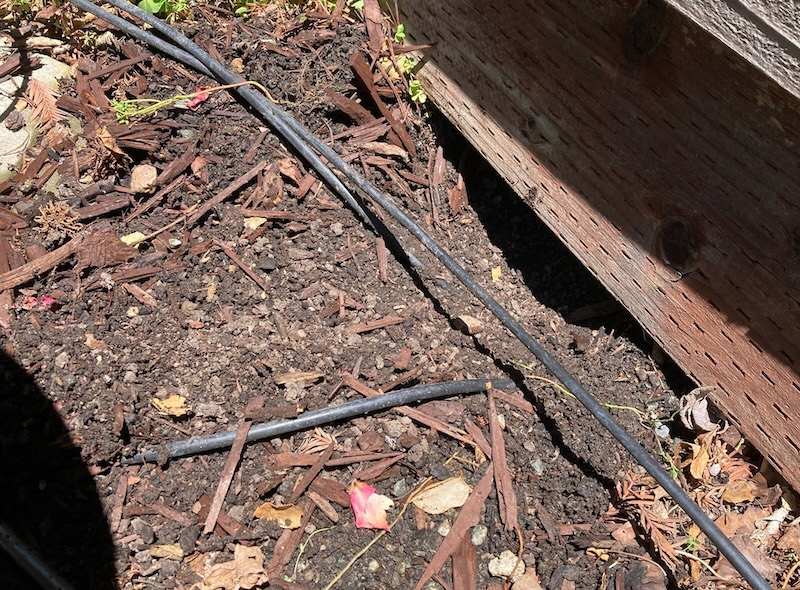
1. Eliminate Food and Water Sources
Start by removing anything that makes your yard attractive to rats.
How to do it:
- Keep garbage in sealed, rodent-proof containers.
- Harvest fruit and vegetables as soon as they ripen.
- Clean up birdseed spills regularly and use squirrel-proof feeders.
- Feed pets indoors or pick up food bowls after meals.
- Repair leaky faucets, hoses, or irrigation systems.
- Drain or cover standing water sources like birdbaths and fountains.
When rats lose access to food and water, they’re more likely to relocate or fall victim to traps.
2. Identify and Monitor Burrows
Before attempting to fill or collapse burrows, figure out if they’re active.
How to do it:
- Sprinkle flour or sand near the entrance at dusk.
- Look for tracks the next morning.
- If there’s no movement after 48–72 hours, the burrow is probably inactive.
3. Destroy Inactive Burrows
Once you’re confident a burrow is vacant, it’s safe to destroy it.
How to do it:
- Use a shovel to break up the tunnel.
- Compact the soil firmly to discourage re-digging.
- Consider laying down gravel, hardware cloth, or concrete mesh below the surface before filling the hole back in. This adds a layer of protection.
Pro Tip: Check the area weekly. Rats are persistent—if they return to the hole, you may need to use additional deterrents to keep them away.
4. Set Traps Strategically
Traps can reduce rat populations as long as you place and use them correctly.
How to do it:
- Use snap traps placed in tamper-resistant boxes for safety.
- Position traps near burrow entrances, along walls, or behind objects where rats feel secure.
- Bait traps with peanut butter, dried fruit, oats, bacon grease, or other food lures that rats are already consuming.
- Check traps daily and dispose of rats promptly to prevent odors and scavengers.
- Avoid glue traps, which are inhumane and often ineffective, especially outdoors.
What Not to Do: Common Mistakes to Avoid
In their desperation to get rid of rats, many homeowners turn to home remedies or hazardous products that can do more harm than good.
Here are a few of the top things to avoid:
1. Ammonia and Household Chemicals
Pouring ammonia or bleach into burrows won’t drive rats away permanently.
After all, rats are smart critters, and it’s easy for them to bypass unpleasant smells by digging deeper.
Plus, toxic fumes can seep into homes if tunnels run beneath the foundation, posing a risk to your health, the soil around your home, and your groundwater.
2. Over-the-Counter Rat Poison
While rodenticides might kill a few rats, they don’t eliminate the entire colony, and they may actually introduce new problems.
Specifically, these products can be dangerous for kids, pets, and wildlife, and dead rats may decay in walls or burrows, creating odor and sanitation issues.
3. Dry Ice or Carbon Monoxide Near Structures
Though dry ice (which releases CO₂) can be effective when used properly in outdoor settings, it’s dangerous when near homes or in enclosed spaces.
Carbon monoxide fumigation (e.g., using car exhaust or hoses) is extremely hazardous and illegal in many areas without proper licensing and equipment.
4. Smoke Bombs and Fire-Based Methods
Smoke bombs rarely penetrate deep enough to reach the entire burrow system.
Plus, they pose fire risks, especially in dry California landscapes. As such, these methods may be restricted by local fire codes.
How Smith’s Pest Management Gets Rid of Rat Holes
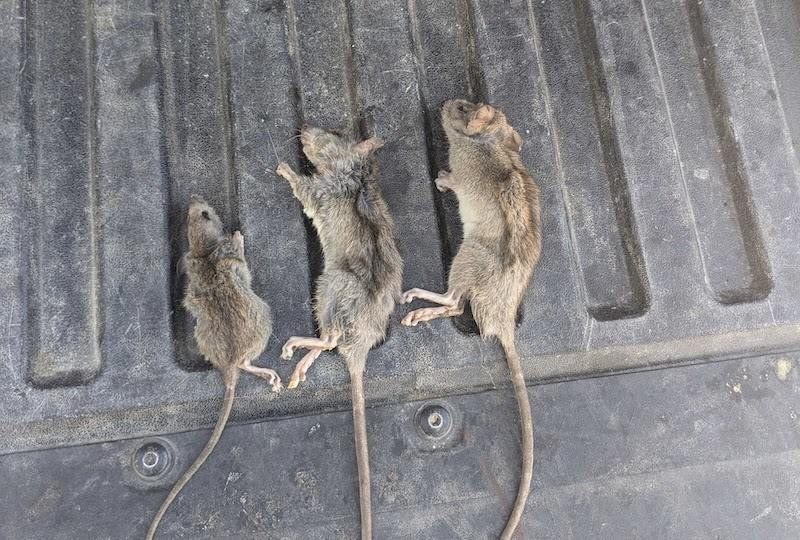
When DIY methods don’t cut it, it’s time to bring in the experts.
At Smith’s Pest Management, we use proven techniques tailored to your specific situation—safely and effectively.
Here’s how we eliminate burrowing rats:
1. Site Inspection and Burrow Mapping
We start with a thorough inspection to locate all active and inactive burrows, feeding areas, and foraging areas.
Mapping helps determine the scale of the infestation and pinpoint the best areas for treatment.
2. Food and Habitat Reduction
Next, our team will work with you to remove access to food, water, and shelter.
This step is essential to getting rid of rats in the long term. After all, traps and other treatments are WAY more effective when rats are hungry and ready to explore new food options.
3. Soil Disruption or Compaction
Where feasible, we break up soil, destroy tunnel systems, and compact areas to prevent re-burrowing.
This deters rats from returning and makes future infestations less likely.
4. Trapping
Next, we set and monitor snap traps, multi-catch stations, and tamper-resistant bait boxes based on rodent behavior and burrow locations.
Our techs check traps regularly and adjust placement as needed.
5. Carbon Dioxide (CO₂) Method
For underground colonies, we may use a CO₂ injection method that floods the tunnels with carbon dioxide, humanely eliminating the rodents.
This is especially effective for Norway rats and is a safer alternative to rodenticides when used correctly.
6. Rodenticides (As a Last Resort)
When all other methods have failed, and the infestation is severe, we may apply restricted-use rodenticides – always in compliance with California’s strict regulations.
These products are handled only by licensed professionals and used with great care and caution.
The safety of your kids, pets, and the local environment is always our top priority!
Don’t Let Rat Holes Destroy Your Yard! We’re Here to Help!
Rat burrows are more than a nuisance—they’re a sign of a persistent rodent problem.
The sooner you take action, the easier it is to protect your yard, your home, and your family.
If you’ve tried DIY methods without success—or just want peace of mind—Smith’s Pest Management is here to help.
We specialize in safe, effective rodent control for California homeowners, from Marin to Monterey..
Ready to learn more? Give us a call to get a quote today: (408) 871-6988.
FAQs
Are rat holes in the yard dangerous?
Yes! In addition to being unsightly, burrows can damage landscaping, destabilize foundations, and create direct access points into your home.
Rats also spread diseases and parasites that can affect humans and pets.
What kind of rat digs in my yard?
Usually Norway rats.
These large, ground-dwelling rats create extensive burrow systems.
Roof rats, while typically found in attics and trees, may occasionally take over old burrows if needed.
Should I fill in rat holes in the yard?
Only after confirming the burrow is inactive. Collapsing an active burrow may cause rats to dig elsewhere or head indoors.
With this in mind, monitor first, then fill.
How can I prevent rats from returning?
Remove food and water sources, block access points, reduce clutter, and maintain landscaping.
Partnering with a pest professional can help maintain a long-term prevention plan.
How can I prevent rat holes?
Once you’ve eliminated an active infestation, focus on prevention to keep rats from returning.
Here’s how:
- Install fencing to keep rats out, being sure to bury at least 12-14” of mesh wire underground to prevent rats from burrowing beneath the fence.
- Seal gaps and cracks in foundations, siding, and utility openings.
- Keep vegetation trimmed and remove clutter or woodpiles from your property.
- Elevate sheds and storage units to get rid of nesting and hiding spaces.
- Regularly inspect your yard for signs of new activity.
- Schedule routine rat inspections with Smith’s Pest Management to stay ahead of rat problems, especially during the spring and fall when rodent activity tends to spike.


